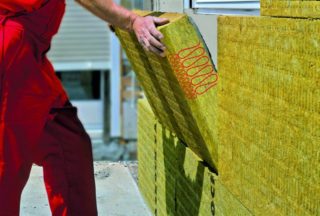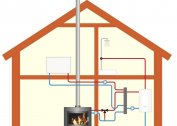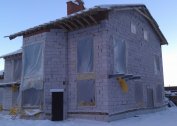If you decide to insulate the walls, it is best to do this from the outside. The insulation can be hidden behind the siding.
Types of external insulation
 There are four types of insulation:
There are four types of insulation:
- A budget option. It is produced by conventional roll insulation, which can be found in any store. Its thickness is 5-20 mm. The insulation must be deployed and attached to the wall, and then install the crate for attaching the siding. Such insulation can be glued directly to the wall. Of course, this type of insulation cannot be called high-quality, but it is better than its absence. With the help of roll insulation, you can also protect the house from the wind.
- Interframe insulation. In this case, the insulation is made of expanded polystyrene or polyurethane plates, which are attached to the lattice cells. The lathing is created from wooden beams, the thickness of which is 3-6 cm more than the insulation. The size of the insulation boards is selected depending on how severe the winters are in a particular region. Plates are fixed between the bars using mastic or special glue. But experts recommend fastening with special spacer fungi made of vinyl, this method is the most reliable. Together with the insulation, a wall is drilled and a special fungus is inserted into the resulting hole, and then a screw is screwed into it. Thus, the hat holds the insulation plate.
- Insulation with a cross frame. This type of insulation is the most expensive. First, the insulation is installed according to the second method. The difference is only the slope of the frame. The bars of the first frame should be horizontal. Then, on top of them, vertical rows of bars are installed. Each layer of the frame is laid with insulation boards. It is also necessary to make additional reinforcement (as in the second version). It is necessary to fix the insulation with glue or special fungi. When using such a cross-section design, the joints of the first insulation layer will not have to be additionally connected, the penetration of cold is completely eliminated. This technology is the best option for a cold climate, but requires considerable costs for the purchase of material.
- Shorties from the remaining boards are attached to the wall. Next, insulation boards are fixed in a couple of layers. In places where the insulation intersects with shorts, the plates must be cut. Fragments of the insulation are attached to the surface of the walls using special glue or fungi. Upon completion of these works, on top of the insulation from wooden battens, it is necessary to assemble the frame for further siding. In this embodiment, it is permissible to use a steel crate instead of wooden beams.
Required insulation properties
 The insulation should have the following properties:
The insulation should have the following properties:
- It must be durable;
- resistant to high temperatures;
- resistant to wear;
- have a stable form;
- perform thermal insulation functions well;
- skip steam well.
The insulation can be replaced with mineral wool. These materials are not a suitable medium for the appearance of mold and other fungi. They have heat and noise insulation qualities, contribute to the absorption of acoustic waves.
The insulation is produced in the form of soft plates, mats and rolls. They also produce hard and medium hard insulation boards, they are needed where the insulation is under load.
Vapor permeability
Mineral wool materials are characterized by high vapor permeability. The vapor that the heater passes through is accumulated in it in the form of moisture, because of this the thermal resistance is lost.In order to avoid this, it is necessary to lay a layer of glassine or a film of polyethylene on the sunny side. You can also use oil paint. Ventilation should be made in the exterior wall decoration to better remove evaporating water.
After the completion of wall insulation, it is necessary to tighten the windbreak membrane around the perimeter of the frame. Such material easily passes steam into the air layer, does not allow water to enter the insulation and walls. This accelerates the drying of the insulation, allows you to prevent its destruction and shedding. The only drawback is the combustibility of the material.
When warming the walls, you must remember to close the joints near the windows. If this is not taken into account, then warming will be almost useless.


